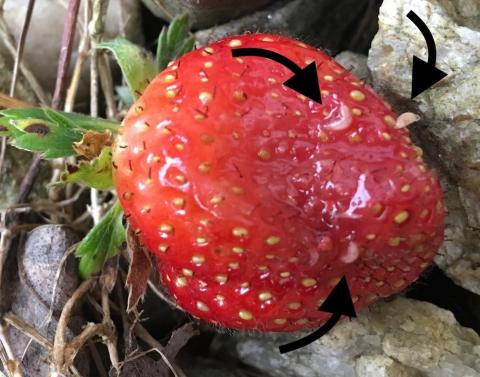Berry growers: be prepared for spotted wing drosophila

Spotted Wing Drosophila (SWD) flies are being caught in traps in CT, MA and RI in low numbers. With the upcoming heat, populations are expected to increase, and SWD is likely to show up in NH soon, so plan ahead. With this timing, the latest ripening June-bearing strawberry cultivars, such as Malwina, summer raspberries, and early ripening blueberries may be at greater risk of SWD infestation than in past years.
Acknowledgements: This note is adapted from an article recently published by Vern Grubinger, UVM Vegetable & Berry Program, and includes information from Laura McDermott and Juliet Carroll, NY state IPM program.
Crop-specific management to reduce SWD infestations
Strawberries: Harvest strawberries thoroughly and renovate (or mow off leaves) promptly after harvest in order to promote breakdown of unharvested fruit. This is especially important if you also grow raspberries or blueberries because there is potential for build-up of SWD populations on strawberry fruit left behind prior to renovation. If you are using herbicides that require a delay of several days after application before mowing (e.g. 2,4-D), make sure that they are effective on your problem weeds, and are worth the necessary delay. Those who do not use herbicides may want to skip mowing altogether; this often spurs the growth of weeds, and temporarily gives them the upper hand over strawberries – allowing them to get a head start.
For strawberry fields in their final picking season, remove them from production as soon as possible by tilling and then seeding a cover crop or a late season vegetable. If you cannot till the field, then mow it close to the crown or cultivate aggressively to help crush and dry down the remaining berries. This will help limit SWD population growth in the remaining late-ripening fruit.
Raspberries: keep rows narrow and thin canes to allow good air circulation and light penetration. SWD prefer cooler, humid, shaded areas of the crop canopy.
Blueberries: eliminate branches below knee high (on mature bushes) that cast shade on the ground and open the upper canopy to allow for good air circulation and light penetration. This will improve spray penetration and efficacy, too. As with other berry crops, maintain an open canopy as much as possible.
Monitor with traps to know what is happening before susceptible fruit begins to ripen. A description of how and why to trap for SWD is found here. New, improved commercial traps and lures are available, including Scentry and Trecé traps. These can be easier to work with than home-made versions. Cost is about $15 per trap with lure. Traps set in field edges typically yield first trap captures of the season. These traps can later be moved into production fields to monitor in-field populations and spray program efficacy.
Harvest frequently (daily if possible) and thoroughly and avoid letting fruit fall to the ground. Anything you can do to to reduce cull fruit left in the field will help reduce SWD infestations. Some growers train harvesters and/or PYO customers to pick cull fruit into a separate container (with some incentive).
Test ripe fruit for infestation: do a salt flotation test to determine how many SWD larvae are present. See this description of how to conduct the SWD salt flotation test, with images.
Refrigerate fruit as quickly as possible; storing at 32-35?F can arrest the development, and even kill eggs/larvae that may be present--if held for several days at that temperature.
If spraying, use a tight schedule (5-7 days) once a crop is ripening and SWD have been confirmed in or near the crop. Spraying in the evening may increase residual efficacy because some materials degrade more quickly in sunlight. SWD is also more active in the evening, especially when the weather is hot.
Add Nu Film P at 4-16 oz per 100 gal with all materials to improve insecticide efficacy. If it rains after you spray a material, re-apply if the label allows.
Here is the current list of insecticides labeled for small fruit for SWD, courtesy of Mary Concklin at UConn Extension. Always read and follow the label to be sure of rates and restrictions.
Organic insecticide options are limited. One multi-year study found Entrust SC to be the most effective spray for SWD control, with Grandevo also showing effectiveness controlling 3rd instar larvae within infested fruit.
Consider insect netting on smaller plantings. This must have 1mm mesh, be applied before ripe fruit are present, and edges must be sealed.
Weed mats beneath blueberry or raspberry bushes may prevents SWD pupae from digging into the soil for protection, though this has not been well studied. Mats may also make removal of fallen berries easier. Mats could be put in place temporarily during the harvest and clan up period, then removed before winter to prevent voles from moving in.
Detailed information on SWD identification, biology, monitoring and management is at:
- Spotted wing drosophila: Biology, behavior and organic management, Andrew Petran, eXtension
- Spotted wing drosophila, by the UMass Extension Fruit Program
- Spotted wing drosophila fact sheets and resources, Michigan State University
Feel free to contact me, or any other member of the UNH Extension Vegetable & Fruit team, with questions or concerns.